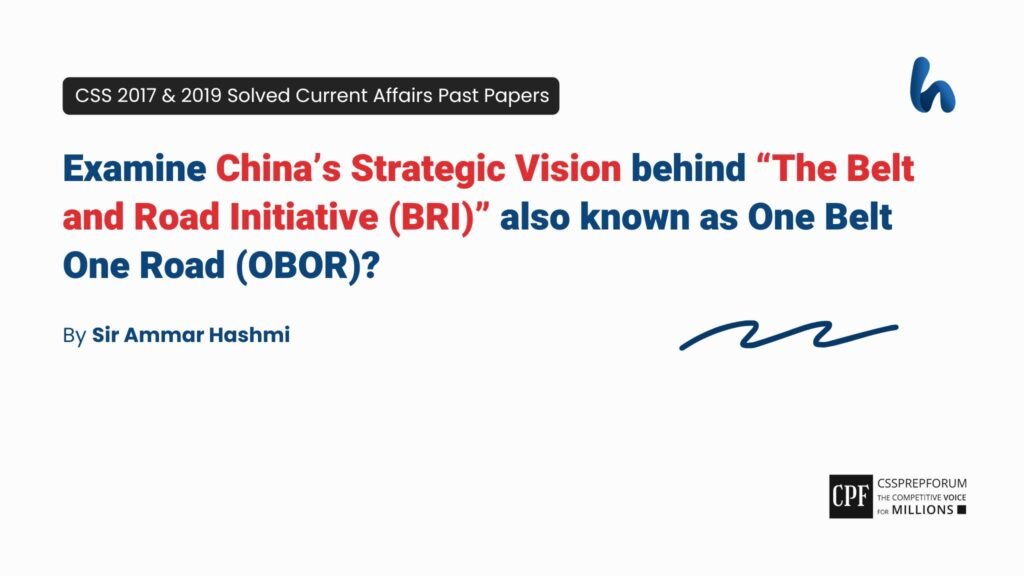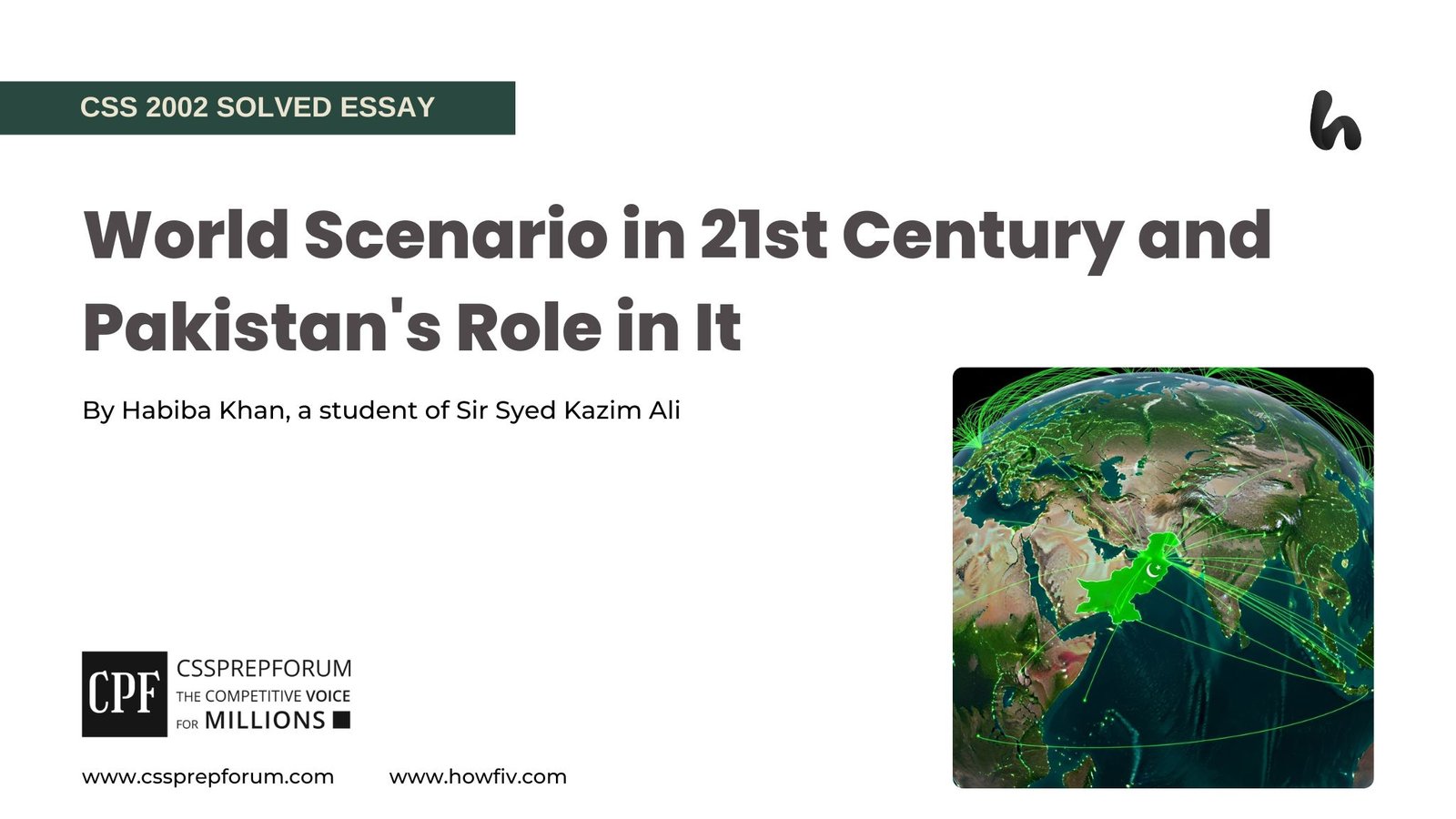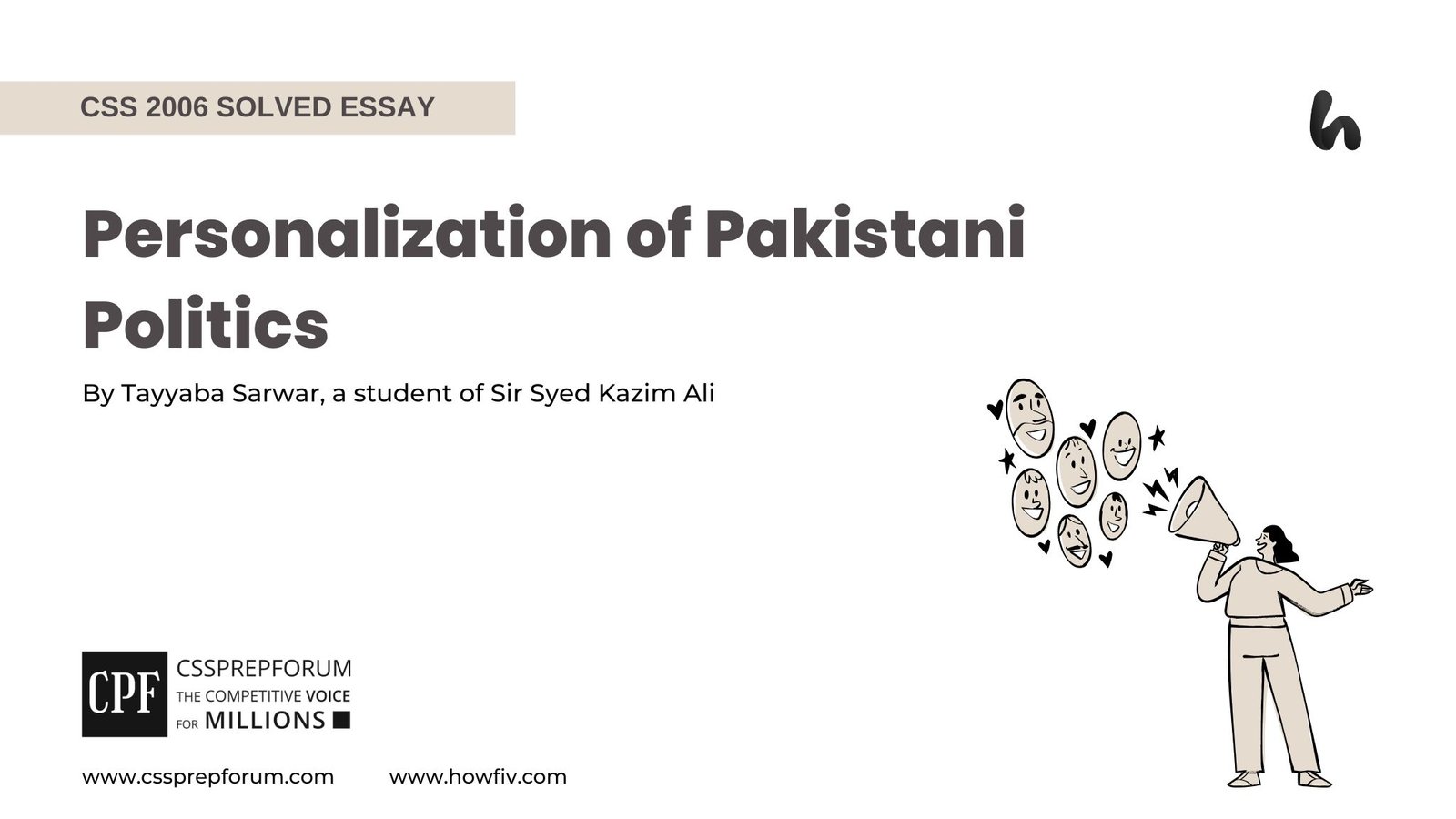CSS 2017 and 2019 Solved Current Affairs Past Papers | China’s Vision behind BRI or OBOR
The following question of CSS Current Affairs 2017 and 2019 is solved by Sir Ammar Hashmi, the best Current Affairs Coach, on the guided pattern of Sir Syed Kazim Ali, which he taught to his students, scoring the highest marks in compulsory subjects for years. This solved past paper question is uploaded to help aspirants understand how to crack a topic or question, how to write relevantly, what coherence is, and how to include and connect ideas, opinions, and suggestions to score the maximum.

Question Breakdown
This question requires an exploration of China’s strategic goals behind the Belt and Road Initiative (BRI). It also includes China’s motivations for enhancing global trade routes and infrastructure. The question also necessitates examining the economic, political, and geopolitical implications for participating countries, such as benefits from improved connectivity and concerns over debt dependency and sovereignty.
Outline
1-Introduction
2-Overview of China’s Belt and Road Initiative (BRI)
3-China’s Strategic Vision and Objectives
- ✓ Economic Focus
- ✓ China’s Geopolitical Influence
- ✓ Promising Energy Security
- ✓ Digital and Technological Connectivity
- ✓ Diplomatic & Political Dimensions
- ✓ Countering the United States
- ✓ Soft power Expansion
- ✓ RMB Internationalization
4-Challenges and Criticism
5-Critical Analysis
6-Conclusion

Answer to the Question
Introduction
China is pursuing global governance strategies that support and affirm international agreements and organizations that align with its norms and goals, such as the World Bank and the Paris Agreement on climate change. The most highlighted example of Beijing’s global governance is the Belt and Road Initiative. The BRI serves as pushback against U.S. “pivot to Asia” diplomacy and as a way for Xi to develop new trade linkages and export markets, enhance Chinese incomes, and successfully export China’s excess productive capacity. Approximately 147 countries, that is, two-thirds of the world’s population (40 percent of global GDP), have agreed to sign on to projects or indicated an interest in doing so. The vision behind BRI includes the creation of a vast network of railways, highways, energy pipelines, and streamlined border crossings, both southward to India, Pakistan, and the rest of Southeast Asia and westward through the mountains of Soviet republics. The Belt and Road initiative not only enhances global trade connectivity, diplomatic ties, and infrastructure development but also serves China’s interests by enhancing its influence across Africa, Asia, and Europe. It secures the supply chains of Chinese companies around the world, but it also creates dependency among countries, raising different concerns.
Overview of China’s Belt and Road Initiative (BRI)
Belt and Road Initiative (BRI) is a Chinese economic project, also referred to as the New Silk Road; it is one of the most ambitious projects encompassing infrastructure that any has ever conceived of the developed nations. It was launched in 2013 under the presidency of Xi Jinping. Initially, the vast collection of investment and development initiatives was devised to link East Asia and Europe through infrastructure. However, the project has recently expanded to Oceania, Africa, and Latin America. It has significantly broadened China’s political and economic influence. Xi (China’s president) announced this initiative during official visits to Indonesia and Kazakhstan in 2013. Originally, the plan was two-dimensional: The Silk Road Economic Belt and the Maritime Silk Road. These two were collectively referred to as the One Belt, One Road initiative, but eventually transformed into the Belt and Road Initiative.
China’s Strategic Vision and Objectives Behind BRI
- ✓ Economic Focus:
The economic goals of BRI centre on expanding investment, infrastructure development, and trade across Asia, Europe, and Africa. Lately, these economic goals have expanded their influence by opening new markets for Chinese companies, promoting the international use of the Chinese currency yuan, and securing supply chains. Financial investments often include projects related to infrastructure like ports, highways, railways, and other power plants. They help countries improve their own economic conditions side by side, creating demand for Chinese goods, technologies, and services. Recently, Beijing has invested over one trillion dollars across one hundred forty countries through the BRI. It has facilitated trade growth among China and BRI countries that reached about nineteen trillion dollars between 2022-2023. Beijing has also secured important assets such as Pakistan (Gwadar) and ports in Greece (Piraeus) and successfully gained access to natural resources, which include energy supplies from Africa and Central Asia.
- ✓ China’s Geopolitical Influence:
It is one of the key strategic visions that extends beyond the economy, aiming to enhance Beijing’s global power, increase influence over participating countries, and strengthen diplomatic ties. China’s investments in infrastructure and offers of financial support to underdeveloped countries have gained political leverage and expanded its presence in strategically important regions of the world.
Lately, China has been able to make deeper ties with Asian, American, European, and African countries effectively, which has expanded its sphere of influence. One of the most highlighted examples is Pakistan, where China has made huge investments in the China-Pakistan Economic Corridor (CPEC), including projects like the Gwadar Port. It was not only an investment and bilateral mutualistic relation, but it also firms China’s footing in the Arabian Sea and access to the Indian Ocean, making it influential in South Asia. In Central Asia, through railways, roads, and pipelines, China has secured critical energy supplies, which have also increased. For instance, Kazakhstan has already received thirty billion dollars in Chinese investment, enhancing it as a key transit hub linking China to Europe.
- ✓ Promising Energy Security:
Energy security is one of the most critical aspects of Beijing’s strategic vision for BRI. Through this initiative, Beijing aims to diversify its secure, stable energy supplies and energy sources and reduce dependency on traditional maritime routes that are vulnerable to several geopolitical risks, like the Strait of Malacca.
One of the major components of this strategy is investments in energy infrastructure, such as power plants, pipelines, and energy grids in BRI-associated countries. For instance, China has invested in oil and gas pipelines that transport these resources directly to its borders in the Central Asian region. The China-Central Asia Gas Pipeline, which passes through Uzbekistan, Turkmenistan, and Kazakhstan, can supply over thirty-five billion cubic meters of natural gas to China annually, boosting China’s energy security. Similarly, in Pakistan, China has developed several hydropower and coal plants under CPEC, which is helping to secure energy supplies at both ends. Examples include the Sahiwal Coal Power Plant and the Karot Hydropower Plant. Other examples may include hydropower dams in Ethiopia, Angola, and Kenya. Statistics show that there are approximately more than forty percent of BRI investments are in energy-related projects, which makes it the largest sector within the BRI.
- ✓ Digital and Technological Connectivity:
China, under BRI, aimed at building a “Digital Silk Road” that will enhance internet infrastructure, promote common technology standards, and deepen space cooperation. This helped China export its technology, expand its influence in digital governance, and secure new markets for its tech companies. One example of this telecommunication infrastructure is 5G networks, satellite systems, and fibre-optic cables. Chinese tech giants such as Huawei and ZTE are leading these efforts. Currently, Huawei is rolling out 5G networks in countries like Kenya, Pakistan, and Thailand. China is helping these nations modernize their communication systems by providing advanced technology and infrastructure while establishing itself as a leader and giant in next-generation technology. It has also invested in undersea cable projects like the Peace Cable, which connects Africa, Asia, and Europe. It will improve data transmission speeds and reduce costs. Beijing is also promoting digitalized payment systems and electronic commerce, such as Alibaba and Tencent. Recent statistics by the Center for Strategic and International Studies (CSIS) highlighted that China’s digital investments are expected to generate over fifty billion dollars annually by 2025.
- ✓ Diplomatic & Political Dimensions:
BRI plays an important role in enhancing China’s influence globally by strengthening political ties, securing strategic partnerships, and creating alliances. It uses infrastructure investments and monetary aid tools to gain political leverage and make deeper diplomatic relationships. One example is its relationship with Pakistan. One of the flagship programs, China-Pakistan Economic Corridor (CPEC), valued at over sixty billion dollars, has significantly strengthened political ties and helped build its infrastructure. This alliance gives China a key ally in a region where it often faces animosity from India. Not only has Pakistan built strong relationships with Cambodia and Laos (other South Asian nations), which are gaining heavy loans and aid from China, and, in return, giving their loyalty to Beijing in the region; for example, China is backed by these two countries in ASEAN meetings. This influence is also visible in Africa, where it made huge investments, such as the Standard Gauge Railway in Kenya, which connects Nairobi to Mombasa.
- ✓ Countering the United States:
The United States has always dominated global trade through the World Trade Organization (WTO), the International Monetary Fund (IMF), and the World Bank. China, through the BRI, is trying to create a non-Western-centric alternative platform for global economic collaboration that will weaken U.S. economic dominance. For instance, the Asian Infrastructure Investment Bank (AIIB) expanded its membership to 106 countries by the end of 2023, with China holding about 26.6% of voting power. This allows China to fund massive infrastructure projects that align with its strategic interests, sidelining the influence of U.S.-controlled institutions. The BRI has also reduced the influence of U.S.-led military alliances like NATO or the U.S. pivot to Asia, which includes partnerships like the Quadrilateral Security Dialogue (Quad) involving India, the US, Japan, and Australia. Africa is one of the prime examples of China challenging U.S. influence, as, between 2013 and 2023, $243 billion of construction contracts have been signed in Africa and for African development, significantly more than any other external player around the globe. This is in contrast to U.S. foreign direct investment (FDI) in Africa, which has stagnated in recent years. From reshaping global trade routes and decreasing dependency on U.S. financial institutions to challenging the U.S. military and digital dominance, China is creating a more multipolar world order, supported by heavy investments, technological advancements, and diplomatic manoeuvring that place China at the forefront of a new global power structure.
- ✓ Soft power Expansion:
Soft power shapes perceptions and influences in ways that make them more favourable to oneself, like China, and the BRI serves as an ideal platform for this kind of expansion. China had constructed over 500 Confucius Institutes worldwide by 2023, mostly in BRI-participating countries. Their aim is to promote the Chinese language and culture, offer international scholarships, and foster academic exchanges. A recent analysis showed that only Africa has more than 60 Confucius Institutes playing a key role in establishing educational and cultural ties with African nations. Not only this, China Global Television Network (CGTN) has also launched its extensions, such as CGTN Africa and CGTN Asia, to broadcast Chinese perspectives on global affairs and developments. It also creates goodwill from China and promotes deeper ties with BRI member countries through public diplomacy. This soft power growth complemented its economic and geopolitical ambitions and was a counteract to compete with the U.S.
- ✓RMB Internationalization:
Renminbi (RMB), the Chinese currency, is gradually being promoted in international trade, investments, and monetary transactions with participating countries. This is to cut on the use of the U.S. dollar, enhance its strategic plans, and boost the power of its financial sectors. The PBOC (People’s Bank of China) reported that over $6.8 trillion of cross-border trade was made using RMB, which is up 37% from 2021 and is largely driven by Russia, Malaysia, and Pakistan. Furthermore, their trade with China increased by 50% in RMB rather than USD after the US sanctions on Russia and Iran in 2022. Likewise, Iran has upgraded its utilization of the RMB in its exports with China while distancing itself from the dollar due to sanctions imposed on it. China has also encouraged the establishment of offshore RMB clearing centers across the world to facilitate the international use of the currency. As of the new statistics of 2023, 27 offshore RMB banks were established in countries like Singapore, Pakistan, Malaysia, and Russia. By encouraging BRI countries to use the RMB in trade settlements, RMB-denominated financial products, and currency swap agreements, China is rapidly increasing the global role of its currency. This not only strengthens its financial system but also reduces the world’s reliance on the U.S. dollar, providing China with greater economic independence and geopolitical leverage.
Challenges and Criticisms
The most highlighted criticism is the risk of debt traps, where participant countries struggle to repay Chinese loans, which will lead to increased dependency on China, as recently seen in Sri Lanka’s lease of Hambantota Port. Critics also said there is a lack of transparency and lingering environmental concerns associated with its projects that bypass local laws and regulations. Additionally, China is also feared for creating geopolitical influence and strategic investments, which have sparked resistance from several countries. These issues also raised concerns about the long-lasting sustainability of multiple projects and the benefits of the BRI.
Critical Analysis
The Belt and Road initiative improves the interaction between international buyers and sellers, diplomatic relations, and infrastructure investment around the world, including in Africa, Asia, and Europe. It also helped China improve its strategic investments in these regions. It consolidates supplies for Chinese businesses globally and establishes dependency on member countries. From a political perspective, it improves Beijing’s soft power around the globe but remains accused of neo-colonialism, most notably in developing nations laden with debts. Generally, the BRI is a transformative project that can capture the shared economic development of the world. Still, its vision is interlinked with its geopolitical objectives, and it has generated a web of cooperation and opposition in the global arena.
Conclusion
China’s BRI stands for the vision that endeavours to dominate the country through infrastructure development investments, economic cooperation, and integration. Through such investment in critical trade routes, Beijing aims to bring the participating countries to the table as its economic partners, meet its energy needs, enter new technology markets, and strategically place itself in a position where it becomes the hub of the new global economy. This project will foster economic gains at one end. Still, at the same time, it also brings into question the debt bondage, geopolitical pressure, and strategic direction, which makes it a powerful but complex tool of China’s diplomacy at the same time.
CSS Solved Past Papers’ Essays
Looking for the last ten years of CSS and PMS Solved Essays and want to know how Sir Kazim’s students write and score the highest marks in the essays’ papers? Then, click on the CSS Solved Essays to start reading them.
CSS Solved Essays
CSS Solved General Science & Ability Past Papers
Want to read the last ten years’ General Science & Ability Solved Past Papers to learn how to attempt them and to score high? Let’s click on the link below to read them all freely. All past papers have been solved by Pakistan’s top CSS GSA coach having the highest score of their students.
General Science & Ability Solved Past Pape












